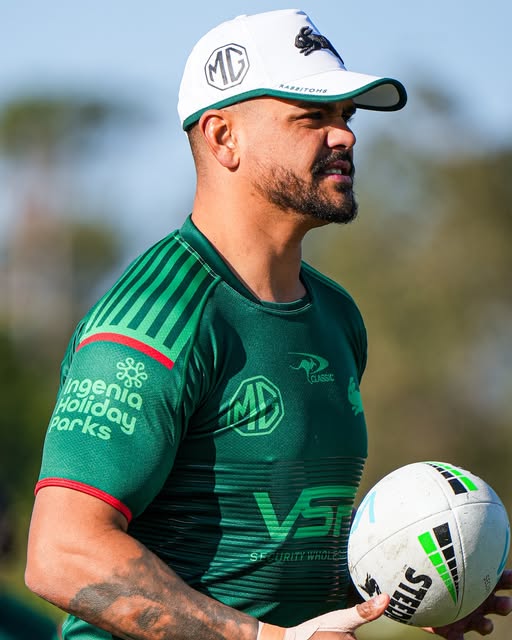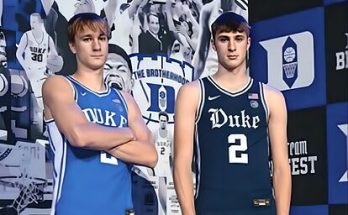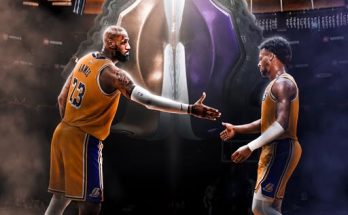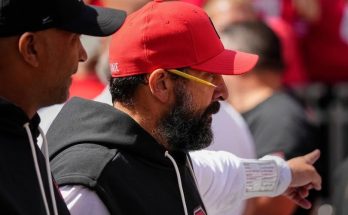Latrell Mitchell, one of the NRL’s most electrifying and polarizing figures, has been ruled out of tomorrow night’s clash against the Penrith Panthers due to a quadriceps injury suffered during a training session earlier today. The news has sent shockwaves through the rugby league community, with fans, analysts, and opponents all scrambling to understand the full implications of his absence—not only for the South Sydney Rabbitohs’ short-term hopes but also for the broader impact on the team’s season and Mitchell’s career.
Injuries are part and parcel of professional sports, but when a player of Mitchell’s caliber is forced out, the ripple effects are far-reaching. Not only is he a star fullback for the Rabbitohs, but he is also one of the most influential Indigenous players in Australian sport. His presence on the field often dictates the rhythm and energy of the game. His absence, therefore, is not just a tactical loss—it’s an emotional and symbolic one too.
The quadriceps muscle group is crucial in rugby league, where short sprints, explosive accelerations, quick changes in direction, and heavy contact are all part of a typical play. Located at the front of the thigh, the quadriceps comprise four distinct muscles: the rectus femoris, vastus lateralis, vastus medialis, and vastus intermedius. These muscles are responsible for extending the knee and are heavily involved in powerful movements like kicking, jumping, and running—all of which are fundamental to Mitchell’s game. A strain or tear in this muscle group can range from mild discomfort to a severe limitation, with recovery timelines that vary based on the grade of the injury.
Details about the exact nature of Mitchell’s injury have not been released, but the fact that he has been ruled out of such a pivotal game suggests the injury is significant enough to warrant caution. With player welfare becoming an increasingly central focus of club and league policy, it makes sense that South Sydney’s medical team is erring on the side of caution, particularly given Mitchell’s injury history and the physical demands of his position.
Mitchell has had a storied career thus far, filled with both moments of brilliance and episodes of controversy. Having made his NRL debut with the Sydney Roosters in 2016, he quickly established himself as a prodigious talent, capable of turning a game on its head with a single play. His combination of strength, speed, and skill is rare, and it’s made him a cornerstone of any team he’s been part of. After moving to South Sydney in 2020, he embraced the fullback role, a position that allows him to have more involvement in both attack and defense. Since then, he’s become the beating heart of the Rabbitohs’ backline—organizing defensive structures, launching counterattacks, and providing that crucial link between the forwards and the halves.
When Mitchell is at his best, South Sydney are a different team. His impact is often felt immediately. He can turn half-chances into tries, convert defensive errors into attacking opportunities, and lift the confidence of those around him. But injuries have unfortunately been a recurring theme in his career. He’s had stints on the sideline due to hamstring strains, shoulder reconstructions, and now a quadriceps issue. The constant interruption of rhythm makes it difficult for any athlete to maintain peak form, and for someone as dynamic as Mitchell, consistency is key to unlocking his full potential.
This latest setback comes at a crucial point in the Rabbitohs’ campaign. The Penrith Panthers, reigning premiers and arguably the most complete team in the NRL, are no easy opponent. Every match against them is a test of physicality, tactical discipline, and mental toughness. South Sydney were already facing an uphill battle, and without Mitchell marshalling the troops from the back, that challenge becomes even steeper.
Beyond the tactical implications, there’s also the psychological element to consider. Mitchell’s teammates look to him for inspiration. He’s one of those rare players who commands attention every time he touches the ball. His leadership on the field—though at times understated—is nonetheless crucial. Players feed off his energy, and his absence can leave a void that’s hard to fill. Even for the coaching staff, Mitchell provides options that few others can replicate. Whether it’s his ability to chime into the attacking line, his vision for a long-range pass, or his brute strength in contact, the playbook is thinner without him.
The South Sydney coaching staff will now be tasked with finding a replacement capable of handling the defensive and offensive responsibilities of the fullback role. Options may include promoting a utility back into the position or reshuffling the backline to cover for his absence. Either way, it’s unlikely that any substitute will bring the same unique skillset that Mitchell offers. This forces the Rabbitohs to not only change personnel but possibly alter their entire game plan.
The decision to sideline Mitchell also reflects a broader shift in how injuries are handled in professional sport. In years past, players were often encouraged—or pressured—to play through pain, particularly in high-stakes matches. But with growing awareness of long-term health risks and the cumulative toll of injuries, teams are becoming more cautious. Medical teams now use sophisticated diagnostic tools, including MRI scans and muscle function testing, to evaluate the extent of injuries. If Mitchell’s quadriceps strain showed signs of internal bleeding or partial tearing, the decision to sit him out becomes not just smart, but essential for his long-term well-being.
Injury prevention and recovery are now as much about science as they are about rest. Modern athletes like Mitchell are supported by a team of physiotherapists, strength and conditioning coaches, dietitians, and sports psychologists—all working in unison to ensure optimal recovery. For a quadriceps injury, treatment might include rest, ice, compression, and elevation (the RICE method), followed by progressive loading and rehabilitation exercises. Eccentric strengthening—where the muscle lengthens under tension—is particularly effective in preventing recurrence. Return-to-play protocols are stringent and based on measurable outcomes like range of motion, muscle strength, and functional tests.
Of course, fans often see only the outcome—whether or not their favorite player takes the field. But behind the scenes is a complex matrix of medical decisions, risk assessments, and individualized care plans. For Mitchell, the goal is not just to return quickly, but to return fully fit and ready to contribute at his best. Rushing back too soon could exacerbate the injury, leading to longer layoffs and potential complications.
From a broader perspective, Mitchell’s injury serves as a reminder of the fragility of athletic careers. No matter how talented or physically gifted a player may be, the human body has its limits. The physical toll of weekly games, intense training, travel, and media commitments can wear down even the most resilient athletes. That’s why squad depth, recovery management, and intelligent rotation have become key aspects of team success in modern rugby league.
This incident also raises questions about the balance between training intensity and injury risk. With clubs constantly seeking to gain an edge, training sessions can be as demanding as match days. High-speed running, contact drills, and positional play are all vital components, but they also carry inherent risks. The art of coaching now involves not just strategy and motivation, but risk management and injury mitigation. It’s likely that the Rabbitohs’ staff will review the training protocols that led to Mitchell’s injury to identify any modifiable risk factors.
Mitchell’s absence will also affect the NRL’s commercial narrative. As one of the game’s most recognizable faces, his presence brings in viewers, sells tickets, and adds spice to any contest. Whether it’s his incredible solo runs, his physical confrontations, or his charismatic post-match interviews, Mitchell is box office. His absence from a marquee matchup like South Sydney vs Penrith inevitably diminishes the spectacle. For broadcasters and sponsors, these moments matter. They want their stars on the field, not on the injury list.
From a fan perspective, reactions will be mixed. Some will lament the absence of their favorite player, while others will worry about the impact on their team’s chances. Critics may point to Mitchell’s injury history and question his durability. But such takes often ignore the physical demands of his role and the responsibility he shoulders week in, week out. Fullback is one of the most taxing positions on the field—requiring not just athleticism but also vision, decision-making, and composure under pressure.
As the Rabbitohs prepare for their showdown with the Panthers, they’ll need to draw on their collective resilience. Injuries are a test not just of depth but of character. It’s an opportunity for younger players to step up, for coaches to innovate, and for the team to rally around a shared objective. Sometimes, adversity can forge unity in ways that success cannot. The Rabbitohs will hope that this setback becomes a turning point rather than a stumbling block.
For Mitchell himself, this latest hurdle is another chapter in a career marked by highs and lows. Few players in recent memory have carried as much expectation, and few have faced as much scrutiny. But through it all, Mitchell has remained a proud, passionate competitor. He wears his heart on his sleeve and plays with a fire that can inspire and intimidate in equal measure. This injury, like those before it, will test his resolve—but if history is any guide, he’ll return stronger and more determined.
In the meantime, the spotlight shifts to those who will take the field in his place. Rugby league, like life, moves quickly. There’s always another game, another opportunity, another challenge. But as the Rabbitohs walk into battle without one of their generals, they do so with the understanding that their season, and perhaps their identity, will be shaped by how they respond—not just to this injury, but to the challenge it represents.
Ultimately, Latrell Mitchell’s withdrawal from tomorrow’s game is more than a news headline. It’s a case study in modern sports medicine, team dynamics, and the human side of elite performance. As fans, we often see only the glory—the tries, the celebrations, the victories. But behind every matchday lineup is a story of sacrifice, struggle, and recovery. Mitchell’s absence reminds us that greatness is not just about what happens when the lights are on, but also about the grit required in the shadows. And it’s in those shadows, during rehab sessions and lonely runs, that champions are made.



